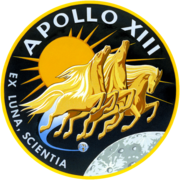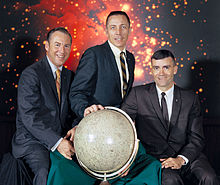 Odyssey's damaged service module, as seen from the Apollo Lunar Module Aquarius, hours before reentry | |
| Mission type | Crewed lunar landing attempt (H) |
|---|---|
| Operator | NASA |
| COSPAR ID |
|
| SATCAT no. | 4371[1] |
| Mission duration | 5 days, 22 hours, 54 minutes, 41 seconds[2] |
| Spacecraft properties | |
| Spacecraft |
|
| Manufacturer |
|
| Launch mass | 44,069 kg (CSM: 28,881 kg;[3] LM: 15,188 kg)[4] |
| Landing mass | 5,050 kilograms (11,133 lb)[5] |
| Crew | |
| Crew size | 3 |
| Members | |
| Callsign |
|
| Start of mission | |
| Launch date | April 11, 1970, 19:13:00 UTC[6] |
| Rocket | Saturn V SA-508 |
| Launch site | Kennedy LC-39A |
| End of mission | |
| Recovered by | USS Iwo Jima |
| Landing date | April 17, 1970, 18:07:41 UTC |
| Landing site | South Pacific Ocean 21°38′24″S 165°21′42″W / 21.64000°S 165.36167°W |
| Flyby of Moon (orbit and landing aborted) | |
| Closest approach | April 15, 1970, 00:21:00 UTC |
| Distance | 254 kilometers (137 nmi) |
| Docking with LM | |
| Docking date | April 11, 1970, 22:32:08 UTC |
| Undocking date | April 17, 1970, 16:43:00 UTC |

 Jim Lovell, Jack Swigert, Fred Haise | |
Apollo 13 (April 11–17, 1970) was the seventh crewed mission in the Apollo space program and would have been the third Moon landing. The craft was launched from Kennedy Space Center on April 11, 1970, but the landing was aborted after an oxygen tank in the service module (SM) exploded two days into the mission, disabling its electrical and life-support system. The crew, supported by backup systems on the lunar module (LM), instead looped around the Moon in a circumlunar trajectory and returned safely to Earth on April 17. The mission was commanded by Jim Lovell, with Jack Swigert as command module (CM) pilot and Fred Haise as lunar module (LM) pilot. Swigert was a late replacement for Ken Mattingly, who was grounded after exposure to rubella.
A routine stir of an oxygen tank ignited damaged wire insulation inside it, causing an explosion that vented the contents of both of the SM's oxygen tanks to space.[note 1] Without oxygen, needed for breathing and for generating electric power, the SM's propulsion and life support systems could not operate. The CM's systems had to be shut down to conserve its remaining resources for reentry, forcing the crew to transfer to the LM as a lifeboat. With the lunar landing canceled, mission controllers worked to bring the crew home alive.
Although the LM was designed to support two men on the lunar surface for two days, Mission Control in Houston improvised new procedures so it could support three men for four days. The crew experienced great hardship, caused by limited power, a chilly and wet cabin and a shortage of potable water. There was a critical need to adapt the CM's cartridges for the carbon dioxide scrubber system to work in the LM; the crew and mission controllers were successful in improvising a solution. The astronauts' peril briefly renewed public interest in the Apollo program; tens of millions watched the splashdown in the South Pacific Ocean on television.
An investigative review board found fault with preflight testing of the oxygen tank and Teflon being placed inside it. The board recommended changes, including minimizing the use of potentially combustible items inside the tank; this was done for Apollo 14. The story of Apollo 13 has been dramatized several times, most notably in the 1995 film Apollo 13 based on Lost Moon, the 1994 memoir co-authored by Lovell – and an episode of the 1998 miniseries From the Earth to the Moon.
- ^ "Apollo 13 CM". N2YO.com. Retrieved August 18, 2019.
- ^ Orloff 2000, p. 309.
- ^ "Apollo 13 Command and Service Module (CSM)". NASA Space Science Data Coordinated Archive. Retrieved January 9, 2023.
- ^ "Apollo 13 Lunar Module / EASEP". NASA Space Science Data Coordinated Archive. Retrieved January 9, 2023.
- ^ Orloff 2000, p. 307.
- ^ "Apollo 13". NASA Space Science Data Coordinated Archive. Retrieved January 9, 2023.
- ^ Williams, David. "The Apollo 13 accident". NASA.
The Apollo 13 malfunction was caused by an explosion and rupture of oxygen tank no. 2 in the service module.
- ^ Cortright 1975, pp. 248–249: "I did, of course, occasionally think of the possibility that the spacecraft explosion might maroon us... Thirteen minutes after the explosion, I happened to look out of the left-hand window, and saw the final evidence pointing toward potential catastrophe. "
- ^ Accident report, p. 143.
- ^ Cooper 2013, p. 21: "Later, in describing what happened, NASA engineers avoided using the word "explosion;" they preferred the more delicate and less dramatic term "tank failure," and in a sense it was the more accurate expression, inasmuch as the tank did not explode in the way a bomb does but broke open under pressure."
Cite error: There are <ref group=note> tags on this page, but the references will not show without a {{reflist|group=note}} template (see the help page).